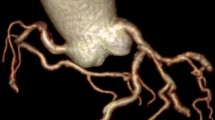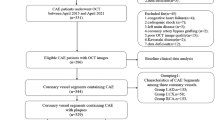Abstract
Etiopathogenesis of coronary artery ectasia (CAE), which is defi ned as abnormal dilatation of a segment of the coronary artery to 1.5 times of an adjacent normal coronary artery segment, is unclear. However, it is speculated that CAE develops in the atherosclerosis process through degeneration of coronary artery media layer. Our objective in this study is to compare levels of adiponectin between cases with CAE and normal coronary anatomy, and to examine whether adiponectin plays a role in CAE etiopathogenesis. The study registered a total of 66 cases, consisting of CAE cases (group 1, n = 36) and cases with normal coronary anatomy (group 2, n = 30). Taking coronary artery diameters of the control group cases as the reference, patients with abnormal segments 1.5 times larger than the adjacent segments were accepted as CAE. Serum adiponectin levels were 4.31 ± 2.02 µg/ml in group 1 and 6.73 ± 4.0 µg/ml in group 2 (P = 0.02). High-sensitivity Creactive protein was 4.8 ± 3.8 mg/l in group 1 and 3.6 ± 3.4 mg/l in group 2 (P > 0.05). There was a negative correlation between ectatic coronary artery diameter and plasma adiponectin level (P = 0.03; r = −0.339). It was known that adiponectin levels dropped in atherosclerotic heart disease. In this study we found low plasma adiponectin levels in acquired CAE, attributed to atherosclerosis. Therefore, we think that adiponectin might be playing a role in etiopathogenesis and progression of CAE. This in turn may indicate that hypo-adiponectinemia may be useful in revealing a realized risk in CAE. However, larger, randomized, multicenter studies are required to examine the role of adiponectin in the development of CAE.
Similar content being viewed by others
References
Hartnell GG, Parnell BM, Pridie RB (1985) Coronary artery ectasia its prevalence and clinical significance in 4993 patients. Br Heart J 54:392–395
Krueger D, Stierle U, Herrmann G, Simon R, Sheikhzadeh A (1999) Exercise induced myocardial ischaemia in isolated coronary artery ectasias and aneurysms (“Dilated Coronaropathy”). J Am Coll Cardiol 34:1461–1470
Markis JE, Joffe CD, Cohn PF, Feen DJ, Herman MV, Gorlin R (1976) Clinical significance of coronary arterial ectasia. Am J Cardiol 37:217–222
Diez JJ, Iglesias P (2003) The role of the novel adipocyte-derived hormone adiponectin in human disease. Eur J Endocrinol 148: 293–300
Ouchi N, Kihara S, Arita Y, Maeda K, Kuriyama H, Okamoto Y, Hotta K, Nishida M, Takahashi M, Nakamura T, Yamashita S, Funahashi T, Matsuzawa Y (1999) Novel modulator for endothelial adhesion molecules: adipocyte-derived plasma protein adiponectin. Circulation 100:2473–2476
Yokota T, Oritani K, Takahashi I, Ishikawa J, Matsuyama A, Ouchi N, Kihara S, Funahashi T, Tenner AJ, Tomiyama Y, Matsuzawa Y (2000) Adiponectin, a new member of the family of soluble defense collagens, negatively regulates the growth of myelomonocytic progenitors and the functions of macrophages. Blood 96:1723–1732
Kubota N, Terauchi Y, Yamauchi T, Kubota T, Moroi M, Matsui J, Eto K, Yamashita T, Kamon J, Satoh H, Yano W, Froguel P, Nagai R, Kimura S, Kadowaki T, Noda T (2002) Disruption of adiponectin causes insulin resistance and neointimal formation. J Biol Chem 277:25863–25866
Swaye PS, Fisher LD, Litwin P, Vignola PA, Judkins MP, Kemp HG, Mudd GJ, Gosselin AJ (1983) Aneurysmal coronary artery disease. Circulation 67:134–138
Haffner SM, Miettinen H, Stern MP (1997) The homeostasis model in the San Antonio Heart Study. Diabetes Care 20:1087–1092
Sorrell VL, Davis MJ, Bove AA (1998) Current knowledge and significance of coronary artery ectasia: a chronologic review of the literature, recommendations for treatment, possible etiologies, and future considerations. Clin Cardiol 21:157–160
Seabra Gomes R, Somerville J, Ross DN, Emanuel R, Parker DJ, Wong M (1974) Congenital coronary artery aneurysms. Br Heart J 36:329–335
Björk VO, Björk L (1967) Intramural coronary artery aneurysm. A coronary artery steal syndrome. J Thorac Cardiovasc Surg 54:50–52
Vieweg WVR, Alpert JS, Hagan AD (1976) Caliber and distribution of normal coronary arterial anatomy. Cathet Cardiovasc Diagn 2:269–280
Swanton RH, Lea Thomas M, Coltart DJ, Jenkins BS, Webb-Peploe MM, Williams BT (1978) Coronary ectasia — a variant of occlusive coronary arteriosclerosis. Br Heart J 40: 393–400
Okamoto Y, Arita Y, Nishida M, Muraguchi M, Ouchi N, Takahashi M, Igura T, Inui Y, Kihara S, Nakamura T, Yamashita S, Miyagawa J, Funahashi T, Matsuzawa Y (2000) An adipocytederived plasma protein, adiponectin, adheres to injured vascular walls. Horm Metab Res 32:47–50
Matsuda M, Shimomura I, Sata M, Arita Y, Nishida M, Maeda N, Kumada M, Okamoto Y, Nagaretani H, Nishizawa H, Kishida K, Komuro R, Ouchi N, Kihara S, Nagai R, Funahashi T, Matsuzawa Y (2002) Role of adiponectin in preventing vascular stenosis. The missing link of adipo-vascular axis. J Biol Chem 277:37487–37491
Kotani K, Sakane N, Saiga K, Kato M, Ishida K, Kato Y, Kurozawa Y (2007) Serum adiponectin levels and lifestyle factors in Japanese men. Heart Vessels 22(5): 291–296
Kumada M, Kihara S, Sumitsuji S, Kawamoto T, Matsumoto S, Ouchi N, Arita Y, Okamoto Y, Shimomura I, Hiraoka H, Nakamura T, Funahashi T, Matsuzawa Y. Osaka CAD Study Group. Coronary artery disease (2003) Association of hypoadiponectinemia with coronary artery disease in men. Arterioscler Thromb Vasc Biol 23:85–89
Gabay C and Kushner I (1999) Acute-phase proteins and other systemic responses to inflammation. N Engl J Med 340:448–454
Biasucci LM, Colizzi C, Rizzello V, Vitrella G, Crea F, Liuzzo G (1999) Role in inflammation in the pathogenesis of unstable coronary artery diseases. Scand J Clin Lab Invest 59:12–22
Turhan H, Erbay AR, Yasar AS, Balci M, Bicer A, Yetkin E (2004) Comparison of C-reactive protein levels in patients with coronary artery ectasia versus patients with obstructive coronary artery disease. Am J Cardiol 94:1303–1306
Finkelstein A, Michowitz Y, Abashidze A, Miller H, Keren G, George J (2005) Temporal association between circulating proteolytic, inflammatory and neurohormonal markers in patients with coronary ectasia. Atherosclerosis 179:353–359
Palomer X, Perez A, Blanco-Vaca F (2005) Adiponectin: a new link between obesity, insulin resistance and cardiovascular disease. Med Clin 124:388–395
Jansson PA, Pellme F, Hammarstedt A, Sandqvist M, Brekke H, Caidahl K, Forsberg M, Volkmann R, Carvalho E, Funahashi T, Matsuzawa Y, Wiklund O, Yang X, Taskinen MR, Smith U (2003) A novel cellular marker of insulin resistance and early atherosclerosis in humans is related to impaired fat cell differentiation and low adiponectin. FASEB J 17:1434–1440
Fujii N, Tsuchihashi K, Sasao H, Eguchi M, Miurakami H, Hase M, Higashiura K, Yuda S, Hashimoto A, Miura T, Ura N, Shimamoto K (2008) Insulin resistance functionally limits endotheliumdependent coronary vasodilation in nondiabetic patients. Heart Vessels 23(1):9–15
Ikeda N, Nakajima R, Tsunoda T, Nakamura M, Sugi K (2007) Insulin resistance and acute coronary syndrome in the young Japanese population have a strong association. Heart Vessels 22: 165–169
Author information
Authors and Affiliations
Corresponding author
Rights and permissions
About this article
Cite this article
Dagli, N., Ozturk, U., Karaca, I. et al. Adiponectin levels in coronary artery ectasia. Heart Vessels 24, 84–89 (2009). https://doi.org/10.1007/s00380-008-1087-0
Published:
Issue Date:
DOI: https://doi.org/10.1007/s00380-008-1087-0




